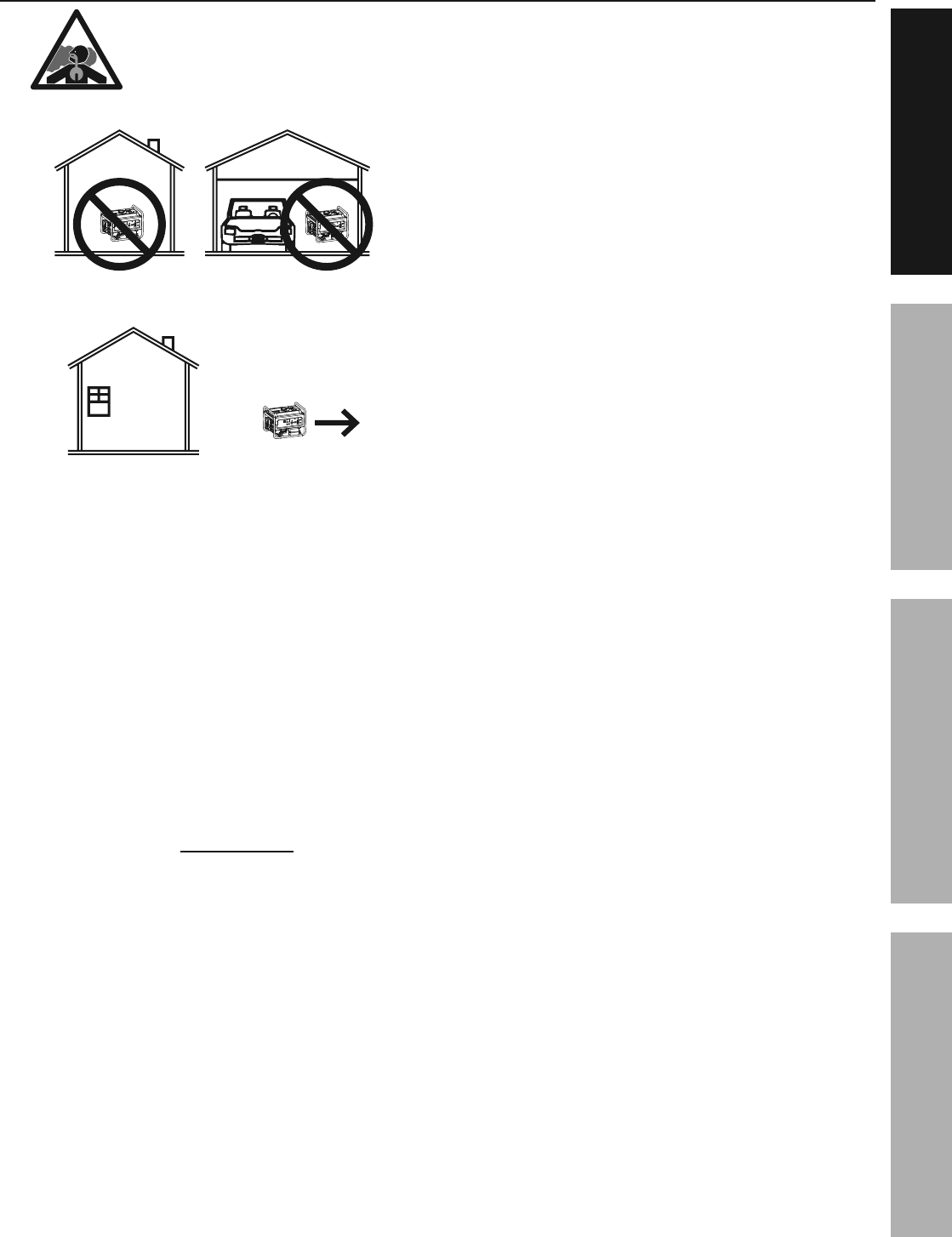
Page 5For technical questions, please call 1-888-866-5797.ITEM 61725
SAFETYOPERATIONMAINTENANCE SETUP
Operating Precautions
1. CARBON MONOXIDE HAZARD
Using a generator indoors
CAN KILL YOU IN MINUTES.
Generator exhaust contains
carbon monoxide. This is a poison
you cannot see or smell.
NEVER use inside a home or garage,
EVEN IF doors and windows are open.
Only use OUTSIDE and far away from windows,
doors, and vents.
2. Never use a generator indoors, including in
garages, basements, crawl spaces and sheds.
Opening doors and windows or using fans will NOT
prevent carbon monoxide build up in the home.
3. When using generators, keep them outdoors
and far away from open doors, windows,
and vents to avoid toxic levels of carbon
monoxide from building up indoors.
4. If you start to feel sick, dizzy, or weak while
using a generator, get to fresh air right away.
The carbon monoxide from generators can
quickly lead to full incapacitation and death.
5. Keep children away from the equipment,
especially while it is operating.
6. Keep all spectators at least six feet
from the Engine during operation.
7. Fire Hazard! Do not fill fuel tank while engine is
running. Do not operate if gasoline has been spilled.
Clean spilled gasoline before starting engine.
Do not operate near pilot light or open flame.
8. Do not touch engine during use.
Let engine cool down after use.
9. Never store fuel or other flammable
materials near the engine.
10. If the plugged in product operates abnormally
or unusually slow, immediately stop using the
generator as a power source. Read and adhere
to the instruction manual of the product to be
powered to make sure that it can be safely and
efficiently powered by a portable generator.
11. Before connecting an appliance or power cord
to the generator: Make sure that it is in good
working order. Faulty appliances or power cords
can create a potential for electrical shock.
12. Do not exceed the maximum power rating of the
generator. Make sure that the total electrical rating
of the all of the tools or appliances plugged into
the generator at the same time does not exceed
that of the generator. Check that the startup surge
will not be beyond the limit of the Generator.
13. Avoid substantially overloading which will trip
the circuit breaker. Slightly overloading the
generator may not trip the circuit breaker,
but will lead to premature generator failure.
14. Do not attempt to connect or disconnect
load connections while standing in water,
or on wet or soggy ground.
15. Do not touch electrically energized parts of
the Generator and interconnecting cables
or conductors with any part of the body, or
with any non-insulated conductive object.
16. Connect the Generator only to a load that is
compatible with the electrical characteristics
and rated capacities of the Generator.
17. Insulate all connections and disconnected wires.
18. Guard against electric shock. Prevent body contact
with grounded surfaces such as pipes,
radiators, ranges, and refrigerators.
19. Only use a suitable means of transport and
lifting devices with sufficient weight bearing
capacity when transporting the generator.
20. Secure the generator on transport vehicles to
prevent it from rolling, slipping, and tilting.
21. Industrial applications must follow
OSHA requirements.
22. Do not leave the generator unattended when it is
running. Turn off the generator (and remove safety
keys, if available) before leaving the work area.
23. The generator can produce high noise levels.
Prolonged exposure to noise levels
above 85 dBA is hazardous to hearing.
Wear ear protection when operating the generator
or when working nearby while it is operating.
24. Wear ANSI-approved safety glasses
and hearing protection during use.
25. People with pacemakers should consult their
physician(s) before use. Electromagnetic fields in
close proximity to a heart pacemaker could cause
pacemaker interference or pacemaker failure.
Caution is necessary when near the
engine’s magneto or recoil starter.


















